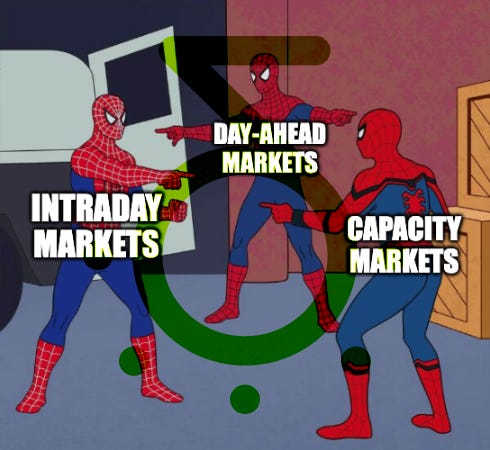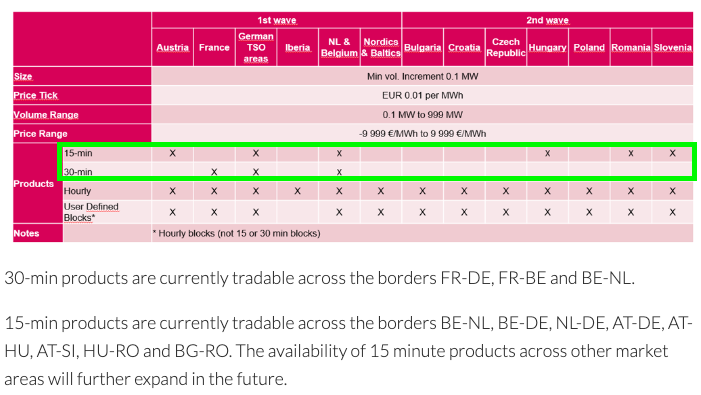Understanding Electricity Markets
What if I told you that there are 11 different electricity markets?
🤘 Howdy to all 840 climate buddies 🌳
Delphi Zero explores topics in climate, energy, and everything in between.
By the end of this essay you will understand:
Why electricity is a very peculiar commodity
Why there are eleven different electricity markets
Let’s do this ⚡️
Understanding Electricity Markets
By Art Lapinsch
Why bother understanding electricity markets?
What Is a Market and Why Is Electricity Special?
Let’s get on the same page.
Basics #1: Definition of a Market
In a previous essay, I compared markets with bazaars:
Think of a middle eastern bazaar where sellers (= supply) and buyers (= demand) meet to have more choice (= market/exchange).
The function of a market is to match the two sides:
🏭 Generation of electricity = Capacity = Supply
🏡 Consumption of electricity = Load = Demand
Basics #2: Electricity as a Commodity
Electricity can be generated in different ways:
🛢️ Non-renewable: Coal is burned to heat water. The resulting steam powers a turbine and generates electricity.
☀️ Renewable: Sun rays are captured by solar PV panels and create an electrical current.
We don’t care where the electricity comes from as long as we can charge our phone. Commodities are defined as “basic goods used in commerce that are interchangeable with other goods of the same type.”
Electricity generated from non-renewables and electricity generated renewably are different but same same.
That’s why we can refer to electricity as a commodity.
Basics #3: Balance of the Grid
Electricity is generated right when it is consumed.
I repeat: Since we currently don’t have a good way of storing electricity at grid-scale, the electricity you use to light your kitchen is created right at the moment when you flip the switch.
This is due to the physics of electricity transmission → when a power plant pushes one electron into the grid there needs to be exactly one electron leaving the grid on the other end.
The Electrical Grid Requires Planning
Let’s revisit our three basic ideas:
Markets match the generation of electricity (i.e. capacity) and the consumption of electricity (i.e. load)
Electricity is a commodity and can be sold to a variety of consumers with different use cases (households vs. industry vs. infrastructure operators)
Electricity generation has to match consumption in real-time
Now, I want to ask you a few questions:
Do you know how many screens I have in my apartment? Do you know at what times I use them on a daily basis? Do you know when I go to sleep?
Probably not. And as a result, it would be difficult for you to estimate my daily electricity consumption.
Multiply this guesswork times the amount of electricity consumers in a country. Et voila, you have a little taste of how difficult it is to predict the exact amount of electricity required on a regular day.
The solution to this problem is information.
Luckily, markets do two things incredibly well:
Share information: Who is in the market? What is their role? What is their ability?
Assign value: How much are market participants willing to pay for something?
This is where electricity markets come into play.
Adieu guess work. Bonjour planning.
The Eleven Electricity Markets
You might have come across technical mumbo jumbo such as Capacity Markets, Re-dispatch, Ancillary Services, RTMs, IDMs, and so on and so on 🙄
Let’s define parameters, which help us understand the different markets:
Why = Purpose: What is the goal?
Who = Participants: Who is trading?
What = Exchange: What is traded?
When = Time: When is the trade happening?
By the end of this section you will understand this figure 👇
These markets correspond with the European electricity market design but in principle, the ideas and functions should apply to other areas as well.
Not all of these “markets” are traded on an exchange but they follow standard market-dynamics where you have at least two participants who exchange different types of value (capacity; commodity; capital).
#1: Capacity Markets
Purpose: Ensure that there is enough generation capacity for peak demand or during times of system stress
Participants: Energy Producers; Energy Traders
Exchange: Energy producers are paid to reserve generation capacity in the event it is needed
Time: This trade usually happens one to four years before the moment of consumption
The important difference in this market is that the buyer doesn’t buy the electricity but they buy the “possibility/capacity of generating electricity”.
Think of it as a contingency plan with a long-term planning horizon. If the active capacity is not enough to balance the grid, then you can tap into the power generators who have agreed to reserve their capacity.
#2: Futures & Forward Markets
Purpose: Buy and sell electricity for future delivery
Participants: Energy Traders
Exchange: Payment is traded for a future delivery of the commodity (i.e. electricity)
Time: One to four years in advance
These are financial markets where participants can buy and sell electricity contracts for future delivery. Futures are standardized contracts, which are usually traded on regulated exchanges. Forwards are private and customizable agreements, which are usually traded over-the-counter (OTC).
In the context of electricity markets, both forward and futures contracts can be used by market participants to hedge against future price fluctuations. For instance, a power producer might sell electricity futures to lock in a certain price for its future output, while a utility might buy electricity futures to secure a predictable price for its future supply needs.
#3: Day-Ahead Market (DAM)
Purpose: Buy and sell electricity for the next day
Participants: Energy Producers; Energy Traders
Exchange: Payment is traded for delivery of commodity (electricity) during the next day
Time: One day before the electricity consumption
This is the most significant electricity market in terms of trading volume in the EU.
The Day-Ahead Market complements the agreements made in the Capacity and Futures & Forward Markets. It makes sense intuitively, since 24 hours before consumption you can estimate the “real” consumption much better than you could a year before the consumption.
Energy producers and consumers submit their bids and offers for each hour of the next day to the power exchange. The market is cleared once per day (noon - 12pm), and the result is a day-ahead schedule of electricity prices and quantities.
The pan-European Day-Ahead Market is facilitated through the Single Day-Ahead Coupling (SDAC) initiative, which integrates the various national electricity markets1. Think of it like running one big electricity shop for the next day.
#4: Intra-Day/Spot Market (IDM)
Purpose: Buy and sell electricity right before consumption
Participants: Energy Producers; Energy Traders
Exchange: Payment for delivery of the commodity (electricity)
Time: Up to 15 minutes before delivery
This market allows participants to adjust their positions based on real-time information, such as unexpected outages or changes in demand or renewable energy production.
The Intra-Day Market2 (IDM) is complementary to the Day-Ahead Market (DAM) in that it allows for just-in-time adjustments closer to the time of electricity consumption. One hour before the consumption we have a much better idea of real demand 👇
Similar to the Single Day-Ahead Coupling mechanism, the European electricity market operators are connecting the various national markets via the Single Intra-Day Coupling (SIDC) initiative.
Trading occurs throughout the day and typically up until one hour before delivery. Yet, there are some markets where trading can be done up to 30 or even 15 minutes before delivery of the electricity.
For more context, I’ve written previously why electricity markets are following along a similar path as digital advertising markets in this essay:
In short, there are three things happening:
Aggregation: National markets are bundled up to a pan-European market
Acceleration: Trading is moving towards real-time frequency
Arbitrage: The recent developments of the electricity market open up arbitrage opportunities
#5: Balancing Services/”Markets”
Purpose: Access capacity to balance the grid just-in-time
Participants: TSO; Energy Producers
Exchange: Payment for just-in-time electricity delivery
Time: Up to 30 seconds before delivery
Balancing services are usually managed by the system operator to balance supply and demand in real time.
This market operates after the closure of the intraday market and ensures that supply and demand are balanced in real-time. Transmission System Operators (TSOs) are responsible for balancing the system and may activate reserves or call on flexible demand to do so.
Balancing the system means balancing the frequency of the European grid, which runs at 50 Hertz (50Hz). If the frequency drops significantly, the system operator (i.e. TSO) calls on its balancing service providers to jump in 👇
Balancing services can be bundled into three groups based on how quickly they can provide balancing energy:
Primary Reserve: Online in up to 30 seconds
Secondary Reserve: Online in up to 300 seconds
Tertiary Reserve: Online in up to 750 seconds
#6: Ancillary Services
Purpose: Access emergency services to ensure grid security
Participants: TSO; Energy Producers
Exchange: Payment for delivery of commodity (i.e. electricity)
Time: Just-in-time
This market includes services necessary to maintain the reliability and security of the grid. This can include frequency regulation, voltage control, and black start capability.
Think of these services as an ultimate back-up when shit hits the fan.
#7: Re-Dispatch
Purpose: Adjust capacity and load
Participants: TSO; Energy Producers
Exchange: Payment for commodity (i.e. electricity) or non-consumption
Time: Just-in-time
Re-dispatch uses two mechanisms:
Upward Activation: Increasing the output from some power plants
Downward Activation: Decreasing the output from other power plants
For example, if there's a sudden surge in electricity demand that wasn't anticipated in the day-ahead and intra-day schedules, the TSO might need to ask certain power plants to increase their output. Conversely, if there's an unexpected drop in demand or a surge in supply from intermittent renewable energy sources, the TSO might need to ask certain power plants to reduce their output.
Power plants are usually compensated for the costs they incur as a result of these re-dispatch actions.
#8: Retail Contracts
Purpose: Sell electricity to end consumers
Participants: Energy Marketers; Energy Consumers
Exchange: Payment for delivery of commodity (electricity) to consumer
Time: Annual contracts
Retail markets involve the sale of electricity from resellers to end-use consumers. Think of your utility contract.
These consumers could be households, businesses, or any entity that consumes electricity. The price of retail electricity typically includes the cost of generation, transmission, and distribution, along with a markup by the retailer.
#9: Bilateral Agreements
Purpose: Procurement of electricity directly from the producer
Participants: Energy Consumer; Energy Producer
Exchange: Payment for delivery of electricity
Time: In advance
These are direct contracts between a buyer and a seller for the purchase of electricity. They are typically used for large quantities and long durations.
Typical parties to such bilateral agreements are companies like Google or Amazon who consume so much energy that it makes sense to procure electricity directly from power plants. They could do it to (a) lock-in a good price over a longer contract period or (b) to procure green electricity from renewable sources to assure renewable electricity in their own consumption.
The typical mechanism for these bilateral agreements are Power Purchase Agreements (PPAs).
In industries such markets are called private marketplaces (PMPs).
#10: Green Certificates
Purpose: Comply with renewable energy standards
Participants: Energy Producers; Buyers of Certificates
Exchange: Payment for Guarantee/Certificate of Origin
Time: At any point after the generation of renewable electricity
Renewable Energy Certificates (RECs) or Guarantees/Certificates of Origin (GoOs; CoOs) can be traded separately from the physical electricity they represent. These certificates confirm that a certain amount of electricity was produced from renewable sources.
These certificates represent the environmental attributes of power produced from renewable energy projects and are used by utilities and businesses to demonstrate compliance with renewable energy standards.
#11: Derivative Markets
Purpose: Hedge against and bet on developments in the electricity markets
Participants: Traders
Exchange: Payment for financial derivative
Time: At any time
These are financial markets where participants trade electricity derivatives such as futures, options, and swaps. These instruments help market participants hedge against the risk of price fluctuations in the physical markets.
Understanding Electricity Markets
Let’s recap the main illustration of this essay 👇
The one idea I’m left with is a “Planning Cascade”.
The closer we get to the time of consumption, the more certain we are of how much electricity is needed (i.e. load) → based on this information, various markets adjust the supply of electricity (i.e. capacity).
[1] Capacity Markets and [2] Futures & Forward Markets plan many years ahead
[3] Day-Ahead Markets (DAM) adjust the long-term plan by making short-term trades a day before the delivery
[4] Intra-Day Markets (IDM) make even finer adjustments up to 15 minutes before the delivery
[5] Balancing Services are used as a fall-back mechanism for unexpected spikes in consumption
Additionally, system operators use [6] Ancillary Services during emergencies and [7] make Re-Dispatch decisions to adjust for short-term deviations of electricity demand.
[8] Most end consumers buy electricity through Retail Contracts, where an energy marketer takes care of energy trading and delivery. [9] Larger consumers can buy electricity directly via Bilateral Agreements. On top, [10] Green Certificates and [11] Derivatives can be traded.
Et voila: Eleven “markets” that each handle distinct electricity-related trades ⚡️
🙏 Thanks Chris for giving me input.
If you enjoyed this essay, please consider forwarding it to a friend who is interested in climate 🌳
If you have feedback/ideas/critique/etc., please get in touch.
Let me know what you liked and what you disliked. What do you want to have more of?
As always, stay healthy, stay happy ✌️
Art
https://eepublicdownloads.blob.core.windows.net/public-cdn-container/clean-documents/Network%20codes%20documents/NC%20CACM/SDAC%202021/SDAC_Statistics_28.10.21.pdf
https://eepublicdownloads.blob.core.windows.net/public-cdn-container/clean-documents/Network%20codes%20documents/NC%20CACM/2023/SIDC_stakeholder_report_0123.pdf

















